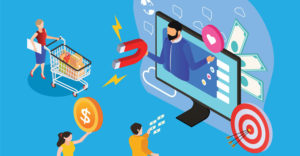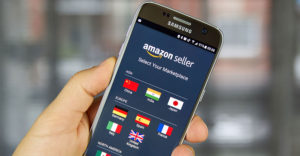Selling on Amazon can be an extremely profitable business all on its own. Third-party sellers like small business owners and authors on Amazon’s marketplace account for 58 percent of gross merchandise volume. This growing space provides a huge opportunity for entrepreneurs to make a massive profit.
However, most entrepreneurs stop the process at only taking a sale rather than scaling it into something great. It’s seven times harder to take on a new customer than it is to get a previous customer to buy from you, and Amazon sellers are particularly bad at turning those sales into long-term customers.
Peter Drucker used to say that there were two functions of the business: getting customers and keeping customers. When you make a sale on Amazon, which of the two functions does it fall under?
Most people answer that question by saying, “getting customers,” but it’s a trick question. It’s neither. It’s Amazon’s customer. Until you get that person to choose you over the competition, it’s not your customer, and you can’t follow up.
There are ethical ways that allow you to scale to be more than an “Amazon business.” When people say that they have an Amazon business, I hear that as, “I don’t have a real business,” because selling on Amazon is a nice profit stream. It’s a good place to start, but it’s not a real business.
Pivoting to Profitability
To make the shift to creating a profitable business from Amazon sales, we have to look at how to get in front of customers both before and after the Amazon purchase. If someone is giving you money in the form of sales on Amazon, that someone is a hot lead for creation of a real customer relationship.
I put a tremendous amount of time and attention into showing up in front of people after they make purchases, through inserts in packaging, retargeting ads and fantastic customer service. We do everything we can to get in front of that person on an ongoing basis after a purchase is made.
The other factor is getting in front of them before purchases are made, which involves audience building. This means identifying who your core customers are and communicating with them in a way that builds goodwill and develops an audience before a purchase is ever made.
We’re putting a significant amount of attention into content creation, speaking to our core audience, and then sending them to Amazon. That’s how we build and scale a real, profitable business. After the purchase, we use things like inserts and packaging and retargeting ads and excellent customer service to get them on an email list or a buyer’s list, so that we can send them follow-up offers and also send them content.
An excellent example to illustrate this is Bulletproof Coffee. Bulletproof Coffee sells a lot of products on Amazon, but it is not an Amazon business. It has a podcast and a blog, and it sells in retail stores. Amazon is one stop along the way.
If founder Dave Asprey wanted to build a coffee company, his second product would have been a dark roast, but that’s not what he did. He did an MCT oil before it was cool to do MCT oil. Based on that, Bulletproof pivoted into food and packaged drinks. It used its brand to create a community that has expanded far beyond Amazon.
Overcoming Hurdles
There are many hurdles entrepreneurs face when selling on Amazon. The first is thinking about the second and third sale. The shift that entrepreneurs have to make is asking themselves, “What happens post-purchase?”
It’s so easy to put a product up in the marketplace today that the temptation is to throw up as many products as possible, get the sale and move on — but all the right action happens after the purchase. That’s when you can turn one-time sales into recurring orders and follow-up purchases, and that doesn’t happen when you’re just putting products up for sale on Amazon.
It’s a big challenge to get entrepreneurs to think beyond the sale and think about what the customer needs after buying the product. What is the journey the customer is on, and how can I support and serve them on an ongoing basis? What can I do that doesn’t just require me to find a new product to sell?
For those of you who are authors getting people to download your audio book or order a book from you, if you aren’t thinking about what the customer might need after the purchase, you’re missing all of the juice in your business — all of the profit that exists in your business.
The other challenge that entrepreneurs make is they tend to think about the product versus the person. This is especially true in audience building. When I talk about audience building, most people think of creating a ton of content, but that’s not necessarily the case. Building the audience is merely having an evident grasp on who your core customers are and the journey they’re on.
As a business, it is one of your jobs to create great products, but that’s only a piece of the overall job of the business. Your job as a business owner is to serve your customers on the journey that they are already on, and you can do that through a variety of different ways: in the way you create content, in the way you represent a message or a brand, in the products you make, and in the experiences you cultivate.
Another excellent example is Legion Athletics, a muscle building company that sells muscle building supplements and books. It got its start selling e-books, and since then has created blog content and an email list.
It really took off when it launched the Legion Athletics supplement line. It had the book purchasers and blog readers coming back to buy more books, products and training, and now it has a coaching program.
It isn’t a book company, a supplement company, a coaching company, or a muscle and fitness company — but it knows that its customers buy all of those things along the journey, and it has undertaken the job of providing those resources for them.
When you think about the person instead of just the product, it opens up new opportunities for you to show up in front of your customers.
Shift Your Mindset
The end goal is to set up your brand up so that Amazon is one stop along the way. If it stops there, you don’t have a real business and are at the mercy of the marketplace.
Anyone can come in and copy you, get more reviews than you, or charge a lower price than you. As a result, you’re always in competition with others rather than building a real business. If you put your attention into the real brand side of that — the audience side of it — and Amazon is part of your overall journey, that’s when you’re in the position to have an amazingly successful and profitable business.
The result is that you have less competition and more customer loyalty, and you’re able to build a business that is scalable and sellable. I have many, many students who have built seven- and eight-figure businesses that are sellable and have sold businesses for US$7 million to $10 million. A lot of that is dialing in the Amazon processes, but also building the other parts of the brand that are so important.
















































Social Media
See all Social Media